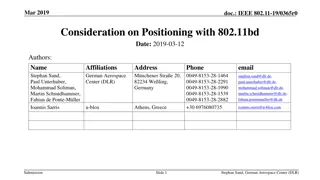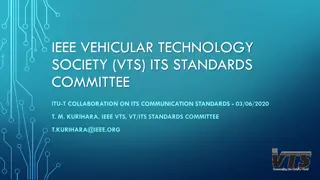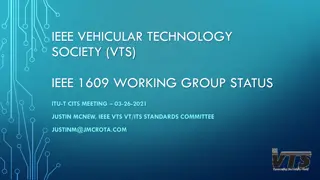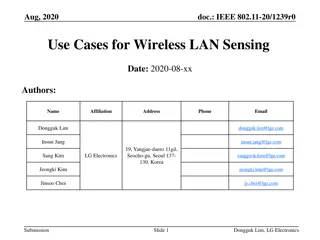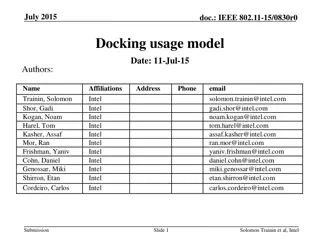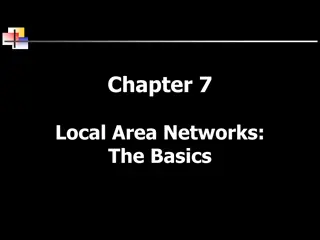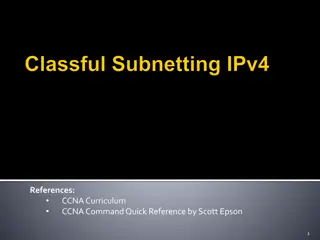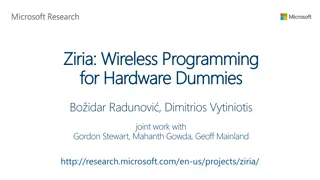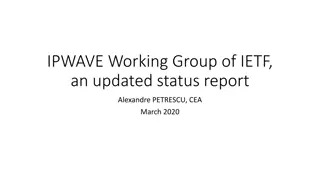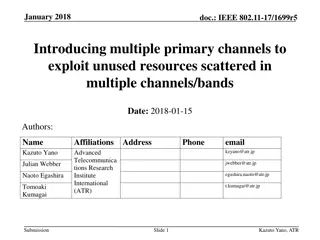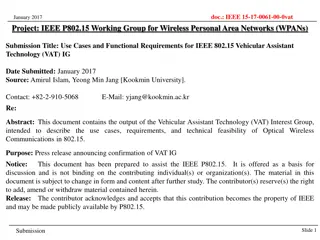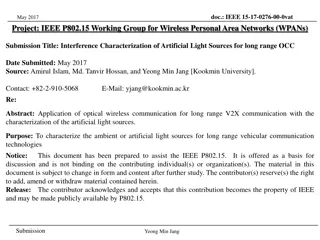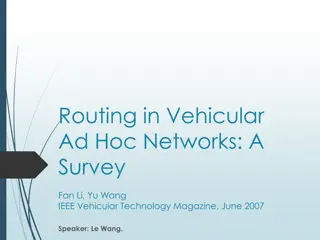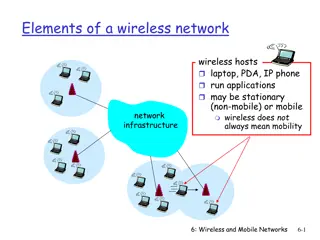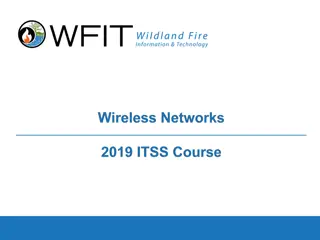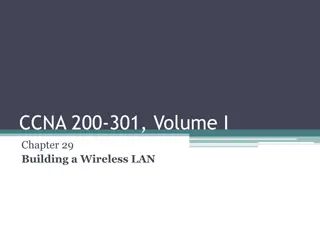Wireless LAN in Vehicular Communications
This submission delves into the utilization of wireless LAN technology within vehicles, highlighting its implications in various scenarios such as traffic jams. The discussion focuses on the challenges and dynamics of intra-vehicle channels affected by vehicle mobility, emphasizing the need for seamless connectivity for both drivers and passengers.
Download Presentation

Please find below an Image/Link to download the presentation.
The content on the website is provided AS IS for your information and personal use only. It may not be sold, licensed, or shared on other websites without obtaining consent from the author.If you encounter any issues during the download, it is possible that the publisher has removed the file from their server.
You are allowed to download the files provided on this website for personal or commercial use, subject to the condition that they are used lawfully. All files are the property of their respective owners.
The content on the website is provided AS IS for your information and personal use only. It may not be sold, licensed, or shared on other websites without obtaining consent from the author.
E N D
Presentation Transcript
Nov 2015 doc.: IEEE 19-15/0084r0 On The Intra-Vehicle Channel Model Date: 21-Oct-2015 Authors: Name Igal Kotzer Affiliations Address General Motors Phone email Submission Slide 1 Igal Kotzer, General Motors
Nov 2015 doc.: IEEE 19-15/0084r0 Abstract In this submission the wireless channel inside a vehicle is discussed. Submission Slide 2 Igal Kotzer, General Motors
Nov 2015 doc.: IEEE 19-15/0084r0 Introduction Wireless LAN is becoming a leading standard in vehicular communications Many vehicle models today have a built in WLAN communication WLAN is present in virtually every consumer electronic device Vehicle manufacturers adapt the vehicles to the changes in consumer electronics WLAN is used in intra-vehicle infotainment systems WLAN can also be used for vehicular sensor linking The number of vehicle models equipped with WLAN is constantly increasing We should aim that both the driver and the passengers get a good connectivity experience comparable to the connectivity experience in the office or at home Submission Slide 3 Igal Kotzer, General Motors
Nov 2015 WLAN Unique Scenarios in Automotive Infotainment doc.: IEEE 19-15/0084r0 Traffic jams Each WLAN equipped vehicle is an AP In traffic jams the distance between vehicles is small and the AP density is high The vehicular APs are typically not jointly controlled or managed In traffic jams there is a slow movement of the vehicles Implications: OBSS (overlapping BSSs) High interference levels Interferers channels change at the speed the vehicles move Submission Slide 4 Igal Kotzer, General Motors
Nov 2015 WLAN Unique Scenarios in Automotive Infotainment (Cont d) doc.: IEEE 19-15/0084r0 Communication between a static AP and a STA in a moving vehicle The intra vehicle channel is affected by the vehicle s surrounding Although the direct path between the AP and the STA is mostly static, the multipath can be affected by the mobility Implications: Long delay spread Doppler PDF proportional to the movement profile and speed Submission Slide 5 Igal Kotzer, General Motors
Nov 2015 doc.: IEEE 19-15/0084r0 Intra-Vehicle Wireless Channel Measurement Setup The wireless channel measurements were performed using the following equipment: GM vehicles: compact size, SUV and a large SUV Network analyser 4 omni-directional WiFi antennas in a 2x2 configuration Distance between each set of 2 antennas is 10 cm Measured frequency bands: 2.4GHz-2.5GHz, 5.150GHz-5.250GHz Vehicle is parked in a stationary environment In this setup there were no driver or passengers in the vehicle Submission Slide 6 Igal Kotzer, General Motors
Nov 2015 Compact Vehicle Channel Measurement Locations doc.: IEEE 19-15/0084r0 Submission Slide 7 Igal Kotzer, General Motors
Nov 2015 doc.: IEEE 19-15/0084r0 SUV Channel Measurement Locations Submission Slide 8 Igal Kotzer, General Motors
Nov 2015 doc.: IEEE 19-15/0084r0 Large SUV Channel Measurement Locations Submission Slide 9 Igal Kotzer, General Motors
Nov 2015 doc.: IEEE 19-15/0084r0 Compact Vehicle Channel Path Loss Submission Slide 10 Igal Kotzer, General Motors
Nov 2015 doc.: IEEE 19-15/0084r0 SUV Channel Path Loss Submission Slide 11 Igal Kotzer, General Motors
Nov 2015 doc.: IEEE 19-15/0084r0 Large SUV Channel Path Loss Submission Slide 12 Igal Kotzer, General Motors
Nov 2015 doc.: IEEE 19-15/0084r0 Intra-Vehicle Wireless Channel Path Loss Measurement results fit the model: ? ? = ??? + ? ? ? - total path loss ??? - mean path loss ? shadowing, log normal zero mean r.v. Submission Slide 13 Igal Kotzer, General Motors
Nov 2015 Intra-Vehicle Wireless Channel Path Loss Log Normal Fit Summary doc.: IEEE 19-15/0084r0 Compact Vehicle 17.3dB SUV Large SUV Mean path loss 19.2dB 18.0dB 2.4GHz Shadowing variance 14.9dB 10.9dB 11.3dB Mean path loss 16.2dB 19.5dB 17.4dB 5GHz Shadowing variance 15.0dB 18.5dB 14.0dB Submission Slide 14 Igal Kotzer, General Motors
Nov 2015 doc.: IEEE 19-15/0084r0 Compact Vehicle Channel Delay Spread Submission Slide 15 Igal Kotzer, General Motors
Nov 2015 doc.: IEEE 19-15/0084r0 SUV Channel Delay Spread Submission Slide 16 Igal Kotzer, General Motors
Nov 2015 doc.: IEEE 19-15/0084r0 Large SUV Channel Delay Spread Submission Slide 17 Igal Kotzer, General Motors
Nov 2015 doc.: IEEE 19-15/0084r0 Intra-Vehicle Wireless RMS Channel Delay Spread Summary Compact Vehicle SUV Large SUV 20.5ns 22.0ns 21.4ns 2.4GHz 19.1ns 21.3ns 21.5ns 5GHz No clustering effect was seen Submission Slide 18 Igal Kotzer, General Motors
Nov 2015 doc.: IEEE 19-15/0084r0 Intra-Vehicle MIMO Channel Matrix Condition Number and Rank All of the measured 2x2 MIMO channel matrices have a rank of 2 The channel matrix s condition number varies significantly between bands and within bands. Based on the measurements the condition number varies between 0dB to 30dB Submission Slide 19 Igal Kotzer, General Motors
Nov 2015 doc.: IEEE 19-15/0084r0 Intra-Vehicle Wireless Channel Measurements Locations A I E 1 4 M O B J 5 F Trunk 2 6 K G C P N 3 L H D 7 Submission Slide 20 Igal Kotzer, General Motors
Nov 2015 doc.: IEEE 19-15/0084r0 Intra-Vehicle Wireless Channel Matrix Condition Number and Rank 3A 3B 3C 3D Condition Number [dB] Condition Number [dB] Condition Number [dB] Condition Number [dB] 3 3 3 3 Channel Matrix Rank Channel Matrix Rank Channel Matrix Rank Channel Matrix Rank 30 30 2.5 2.5 2.5 2 2 2 2 20 20 20 1.5 1.5 1.5 15 1 1 1 1 10 10 10 10 5 5 0 0 0 0 2.4 2.4 2.42 2.42 2.44 2.44 Freq. [GHz] 3E 2.46 2.46 2.48 2.48 2.5 2.5 2.4 2.4 2.42 2.42 2.44 Freq. [GHz] 3F 2.44 2.46 2.46 2.48 2.48 2.5 2.5 2.4 2.4 2.42 2.42 2.44 2.44 Freq. [GHz] 3G 2.46 2.46 2.48 2.48 2.5 2.5 2.4 2.4 2.42 2.42 2.44 2.44 Freq. [GHz] 3H 2.46 2.46 2.48 2.48 2.5 2.5 Condition Number [dB] Condition Number [dB] Condition Number [dB] Condition Number [dB] Channel Matrix Rank Channel Matrix Rank Channel Matrix Rank Channel Matrix Rank 3 3 3 3 30 2.5 2.5 2.5 2 2 2 2 20 20 20 1.5 1.5 1.5 15 15 1 1 1 1 10 10 10 10 5 5 5 0 0 0 0 2.4 2.4 2.42 2.42 2.44 2.44 Freq. [GHz] 3I 2.46 2.46 2.48 2.48 2.5 2.5 2.4 2.4 2.42 2.42 2.44 Freq. [GHz] 3J 2.44 2.46 2.46 2.48 2.48 2.5 2.5 2.4 2.4 2.42 2.42 2.44 Freq. [GHz] 3K 2.44 2.46 2.46 2.48 2.48 2.5 2.5 2.4 2.4 2.42 2.42 2.44 2.44 Freq. [GHz] 3L 2.46 2.46 2.48 2.48 2.5 2.5 Condition Number [dB] Condition Number [dB] Condition Number [dB] Condition Number [dB] 3 3 3 3 Channel Matrix Rank Channel Matrix Rank Channel Matrix Rank Channel Matrix Rank 30 2.5 2.5 2.5 2 2 2 2 20 20 20 1.5 1.5 1.5 15 15 1 1 1 1 10 10 10 10 5 5 5 0 0 0 0 2.4 2.4 2.42 2.42 2.44 Freq. [GHz] 3M 2.44 2.46 2.46 2.48 2.48 2.5 2.5 2.4 2.4 2.42 2.42 2.44 2.44 Freq. [GHz] 3N 2.46 2.46 2.48 2.48 2.5 2.5 2.4 2.4 2.42 2.42 2.44 2.44 Freq. [GHz] 3O 2.46 2.46 2.48 2.48 2.5 2.5 2.4 2.4 2.42 2.42 2.44 Freq. [GHz] 3P 2.44 2.46 2.46 2.48 2.48 2.5 2.5 Condition Number [dB] Condition Number [dB] Condition Number [dB] Condition Number [dB] Channel Matrix Rank Channel Matrix Rank Channel Matrix Rank Channel Matrix Rank 3 3 3 3 30 30 30 2.5 2.5 2.5 2.5 2 2 2 2 20 20 20 20 1.5 1.5 1.5 1.5 15 1 1 1 1 10 10 10 10 5 0 0 0 0 2.4 2.4 2.42 2.42 2.44 2.44 Freq. [GHz] 2.46 2.46 2.48 2.48 2.5 2.5 2.4 2.4 2.42 2.42 2.44 Freq. [GHz] 2.44 2.46 2.46 2.48 2.48 2.5 2.5 2.4 2.4 2.42 2.42 2.44 Freq. [GHz] 2.44 2.46 2.46 2.48 2.48 2.5 2.5 2.4 2.4 2.42 2.42 2.44 Freq. [GHz] 2.44 2.46 2.46 2.48 2.48 2.5 2.5 Submission Slide 21 Igal Kotzer, General Motors
Nov 2015 doc.: IEEE 19-15/0084r0 Intra-Vehicle Wireless Channel Discussion The RX power of an intra-vehicle WLAN system is strong relative to indoor scenarios, that is the system is not Rx power limited The variance of the path loss shadowing in the 5GHz band is higher in large vehicles than the 2.4GHz band variance Intra-vehicle delay spread in nomadic confined area scenarios is shorter than current WLAN indoor channel models, hence supported by current standards Submission Slide 22 Igal Kotzer, General Motors
Nov 2015 doc.: IEEE 19-15/0084r0 Intra-Vehicle Wireless Channel Discussion (2) The intra-vehicle channel delay spread is very short, thus it is possible to shorten the CP and gain efficiency It is theoretically possible to achieve full 2x2 MIMO, however due to large changes in the streams power it is hard to implement practically. Addressing this issue, especially in a non Rx power limited environment can increase performance. Submission Slide 23 Igal Kotzer, General Motors


